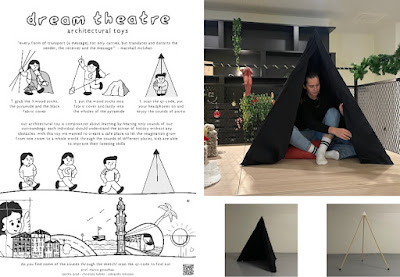One of the things I like about teaching is that even if I repeat the course every year, the results always change. Because students are always different, with different profiles, backgrounds and interests.
Despite that, this year I decided to change some things in the course, starting with the name. Now it is called "The ludic construction of architecture", paraphrasing the well-known book by Giorgio Grassi "The logical construction of architecture".
In addition, I reorganized the classes, synthesizing the subject and leaving more time to follow the work.
The result was many more candidates and works with a very high quality level.
Here some examples:
Pietro Alfano and Gábor Houchard work is inspired by the game Cadavre exquis (exquisite corpse), a collaborative drawing approach first used by surrealist artists to create bizarre and intuitive drawings. With a careful selection of images, the user can create several configurations that combine basements, facades and roofs.
Inês Dias worked on the "Teatrino scientifico", a device designed by the italian architect Aldo Rossi in 1979 in order to simulate architectural proposal in a theatrical context. Ines rebuild the object with some variations but respecting the main idea and functioning.
Barbara Rodrigues was seduced by the work of Alma Siedhoff-Buscher (1899-1944) and her participation at the Bauhaus. Specifically the design for the furniture in the prototype Haus am Horn, designed for kid's playroom. Barbara designed an interpretation of this idea with some upgrades.
The group composed by Sandra Asad, Christina Hübler and Edoardo Trevisan addressed the theme of the relationship between space and ambient sound. created a tent that isolates acoustically and visually from the outside. Inside, a small speaker can play sounds from various places, from the city to the countryside, to promote the child's imagination.
Diana Afonso, Lorena Stoe and Mafalda Pires designed a playground based on several elements, all of them based on a cube, that allow different space experiences. The elements are placed in the territory according to a regular grid that increases the relationships between them.
JuhoTurpeinen was looking for an idea for a toy that allows play with landscape. Creating mountains, hills and valleys in an easy way is now possible with his toys made by cardboard. The several plaques that represent the level curves are magnetic and can be combined in several different way. To the original pieces, the child can add other element that can enrich the game.
Ana Catarina Silva was interested by the Japanese wooden joints and, based on a fantastic manual, developed a construction toy. She produced all the pieces by 3D printing technique and the result is a colored set that fit in a plastic box.
Damiano De Vecchi was inspired by the work of the german architect Alexander Brodsky and developed "The reflection theatre", that is a device used to allow several points of view of the same object. It's an easy and simple toy that can be used with several kind of objects and accompanied by several different narratives.
Júlia_Verri & Lennard_Flörke started with a puzzle/domino game that allow the creation of different architectural plans. Based on this idea they selected some known architects and buildings and start a work of graphical compatibility between the plans. The result is a creative domino that mix the architecture of Andrea Palladio with Mies van Der Rohe, Le Corbusier, Alvar Aalto, between others. You know how it starts, you never know the final plan.
Katerina Kunzova is passionate about molding, and she created a molding system based on folding paper system. The game has some paper sheets with schemes to mold columns and pillars inspired in diferente architects: Pier Luigi Nervi, Valerio Olgiati, James Stirling, Aldo Rossi, Mies van der Rohe and Hans Hollein. Each element can be made by molding and the result is something unexpected because the paper is not rigid and the shapes become organic and irregular.
Piera Ponce designed a toy based on mathematics and geometry. Through the work of the portuguese artist Enuardo Nery she understood how is possible create a tile that can combine with others without pattern interruptions and applied this principle in a toy made by 16 cubes that you can combine as you want creating a huge quantity of different patterns.
Last but not least the work of Sofia Tarfanelli is a carpet that can be used both outside or inside. With a vivid color graphic, kids can play several deferents games with the same carpet that has a large size (4x4 mts) and can be easily transported in order to transform each place in a playground.












No comments:
Post a Comment